We have a busy week ahead with the Federal Reserve and the Bank of England voting on whether to keep interest rates unchanged, which could allow the stock market to regain some strength. Furthermore, China will report on its manufacturing PMI data, possibly continuing its recent expansion. At the same time, Germany will provide preliminary data on whether it has managed to avoid sliding into a recession with its Q3 2023 GDP growth data. Inflation in the Eurozone and the unemployment rate in the US may provide investors with feedback on how the current monetary tightening policy is affecting the broader economy. Simultaneously, numerous companies continue with their Q3 2023 earnings report announcements.
Table of contents:
- China Manufacturing Purchasing Managers Index PMI (October)
- Germany Gross Domestic Product (GDP) QoQ (Q3 preliminary)
- Eurozone Consumer Price Index (CPI) YoY (October)
- Federal Reserve Interest Rate Decision
- Bank of England Interest Rate Decision
- US Unemployment Rate (October)
- Stocks to watch
Tuesday 31.10. 01:30 GMT, China Manufacturing Purchasing Managers Index PMI (October)
The PMI index for China's manufacturing sector is a monthly indicator that measures economic activity in the sector. It is compiled by the China Federation of Logistics & Purchasing (CFLP) and the China Logistics Information Centre (CLIC) based on data provided by the National Bureau of Statistics (NBS). The Li & Fung Research Center compiles and provides the PMI report in English.
More than 700 manufacturing companies across China receive questionnaires about their purchasing and supply situations each month. As reported by purchasing managers, the PMI provides insight into the manufacturing industry's activity level. This measure provides an understanding of the state of China's manufacturing industry, as it is assumed that purchasing managers have access to first-hand data on the performance of their companies. A reading above 50 indicates expansion, while a reading below 50 indicates contraction.
In September 2023, China's Manufacturing PMI showed improvement, increasing to 50.2 from 49.7 in August. It exceeded market expectations of 50.0 and marked the first expansion in factory activity since March. The boost in manufacturing activity could be attributed to recent economic stimulus measures implemented by Beijing to support the country's recovery.
Several key indicators within the PMI survey pointed to this positive trend. Factory output continued to rise for the fourth consecutive month, with the rate of expansion reaching its highest level in six months, registering at 52.7, compared to 51.9 in August. New orders also saw a steady increase, extending the growth for the second consecutive month, with a reading of 50.5, up from 50.2. Moreover, purchasing activity showed a slight strengthening, with a reading of 50.7, compared to the previous 50.5.
In terms of business sentiment, confidence remained positive, with a reading of 55.5, slightly down from 55.6. This indicates that manufacturers continue to hold an optimistic outlook regarding future business conditions. However, it's important to monitor the ongoing challenges, such as weak employment and the dynamics of input and output prices, which could influence the sustainability of this recovery.
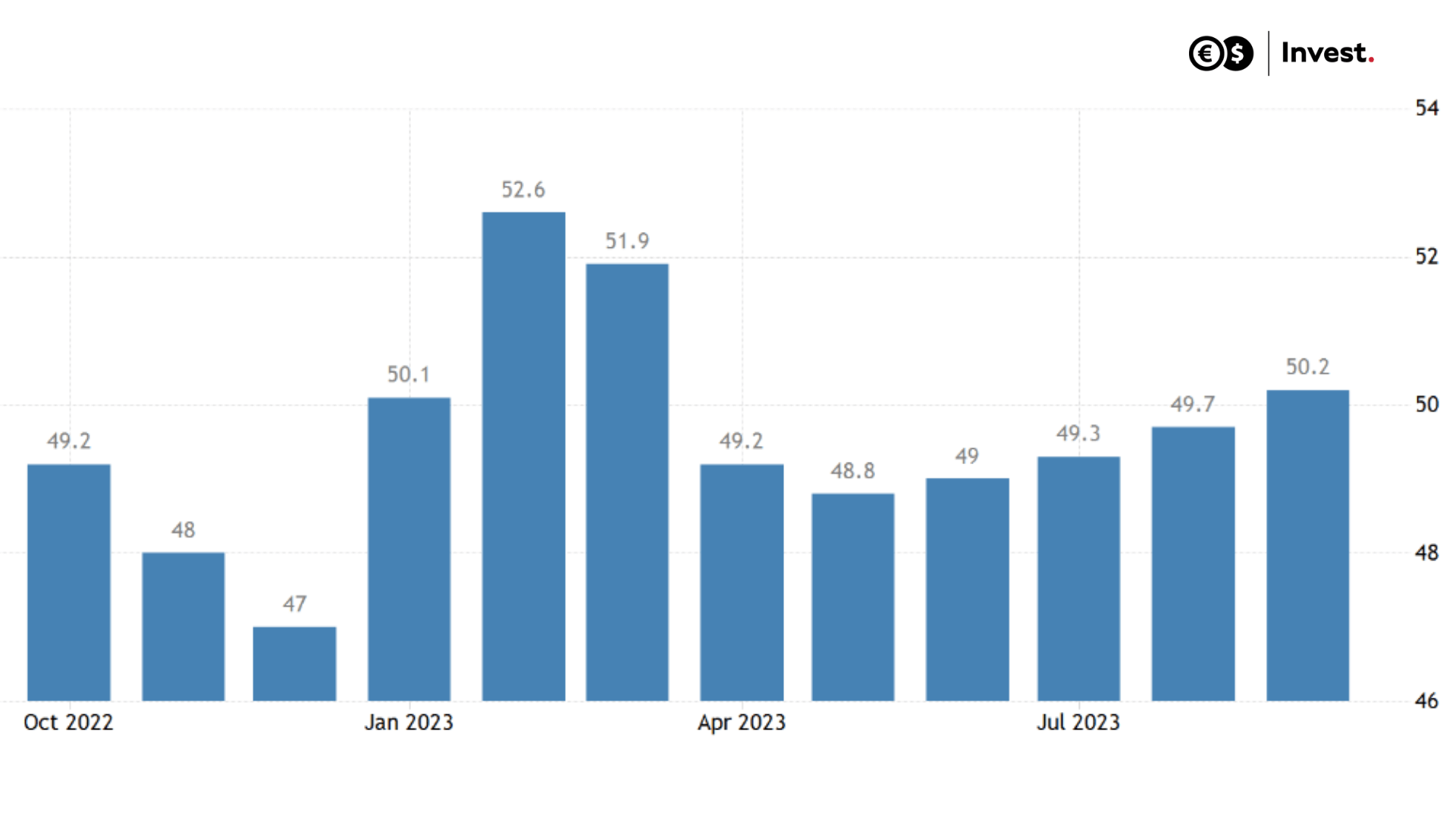
Source: Tradingeconomics.com
A higher-than-expected reading may have a bullish effect on the CNY, while a lower-than-expected reading could be bearish for the CNY.
Impact: CNY
Tuesday 31.10. 09:00 GMT, Germany Gross Domestic Product (GDP) QoQ (Q3 preliminary)
Gross domestic product (GDP) indicates the total value of goods and services produced in a country for a certain period. GDP is an important indicator of the health of an economy because it gives an overall picture of how well or poorly it is doing. If the GDP growth is higher than expected, the economy is in good shape and growing faster than expected. On the other hand, if the GDP growth is lower than expected, the economy performs weaker than anticipated.
In the second quarter of 2023, the German economy exhibited a period of stagnation when compared to the previous three months. This followed two consecutive quarters of economic contraction. During this period, household consumption managed to stabilise after a prior decline in the preceding winter half-year, and government spending showed a modest increase of 0.1%, effectively marking the end of a year-long recessionary phase.
However, it's worth noting that the growth rate in gross fixed capital formation experienced a significant slowdown, decelerating to 0.4% from the 1.7% seen in the first quarter. This deceleration was primarily attributed to reduced investments in the construction sector (0.2%, down from 2.7%) and machinery and equipment (0.6%, down from 2.1%).
Regarding its contribution to GDP growth, inventory changes played a role by adding 0.4 percentage points. However, the external demand component had a detrimental effect, subtracting 0.6 percentage points, mainly due to a decrease in exports.
When examining the German economy's performance on a yearly basis, it experienced a contraction of 0.2% in the second quarter. This represents a continuation of the economic challenges in Europe's largest economy, which is struggling with issues relating to investment, exports and overall growth. According to analysts at Trading Economics, the first preliminary data for German GDP growth in the third quarter is expected to show a contraction of -0.1%.
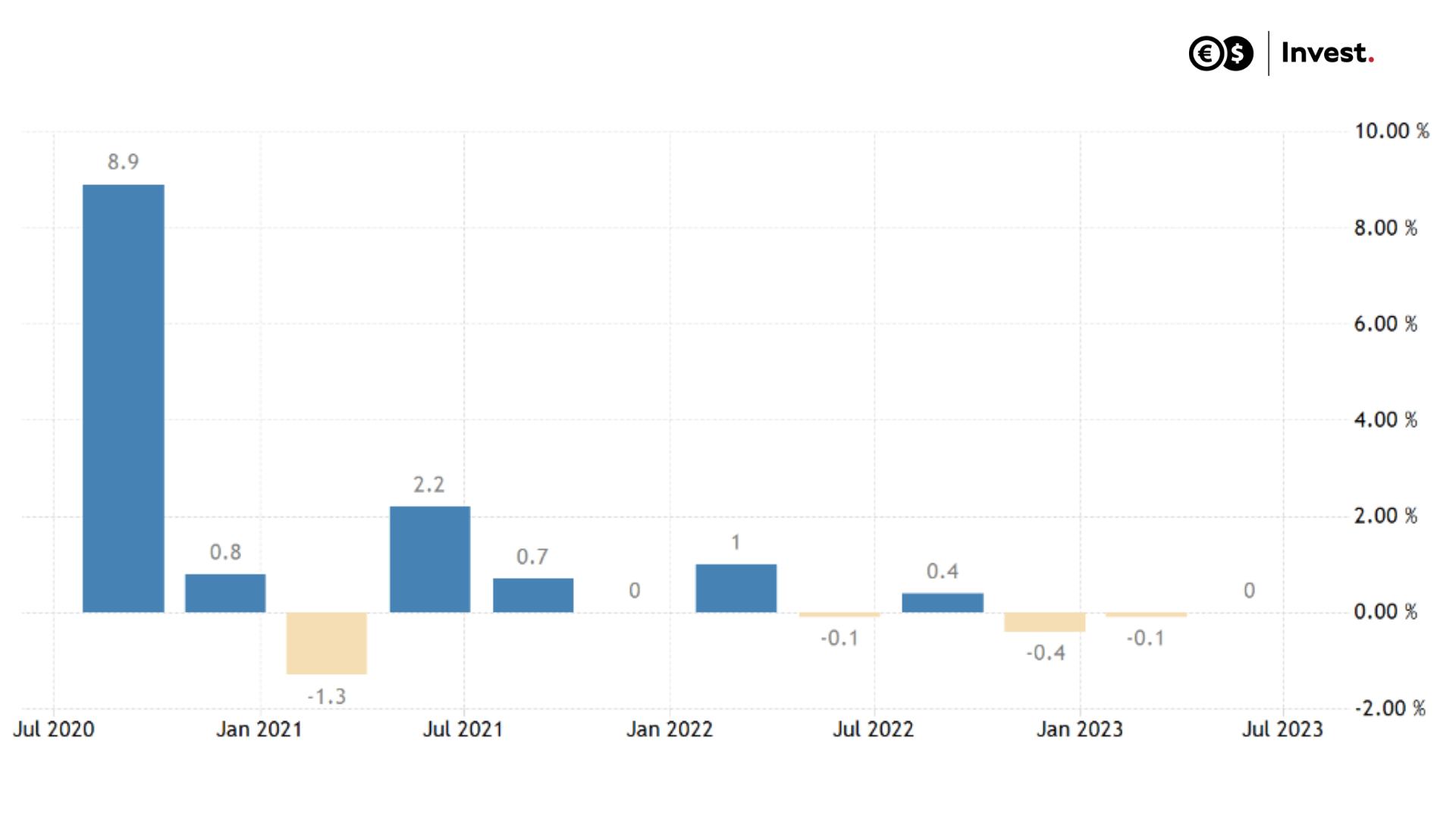
Source: Tradingeconomics.com
A higher-than-expected reading may have a bullish effect on the EUR, while a lower-than-expected reading could be bearish for the EUR.
Impact: EUR
Tuesday 31.10. 10:00 GMT, Eurozone Consumer Price Index (CPI) YoY (October)
The Consumer Price Index (CPI) is a tool used to monitor changes in the prices of goods and services that consumers buy. The CPI is an important indicator because it helps us understand the trends in consumer purchases and how inflation affects their purchasing power. The CPI is calculated based on a basket of goods and services representing typical consumer spending. It includes various categories such as food, housing, transportation, health care, etc. Regular measurements of the CPI allow us to track how the prices of these products and services change over time. A positive CPI indicates an overall increase in the prices of goods and services. On the other hand, a negative CPI means that prices are lower than the year before. By analysing its changes, economists and policymakers may assess the impact of inflation on the economy and take appropriate action. The CPI also matters to consumers because it helps them understand how their money is losing value in the context of rising or falling prices. This information allows them to adjust their spending, plan savings, or make other financial decisions.
In September 2023, the Eurozone's inflation rate was officially verified at 4.3% on a year-on-year basis. This marked a notable decrease from the 5.2% rate observed in August and represented the lowest level of inflation since October 2021. The deceleration in inflation was primarily attributed to a slower increase in prices for various categories, including services (4.7% in September compared to 5.5% in August), non-energy industrial goods (4.1% compared to 4.7%), and food, alcohol, and tobacco (8.8% compared to 9.7%). In contrast, energy costs continued to decline, with a rate of -4.6% in September, as opposed to -3.3% in August.
Furthermore, the core inflation rate, which excludes the more volatile components of food and energy prices, was also confirmed at 4.5% in September. This figure represented the lowest level of core inflation since August 2022.
Among the Eurozone's largest economies, the Harmonized Index of Consumer Prices (HICP) rates experienced various changes. Notably, Germany recorded a decline in its inflation rate to 4.3% in September, down from 6.4% in the previous month. The Netherlands also saw a significant shift, as its inflation rate dropped to -0.3% in September, a notable reduction from the 3.4% rate in August. In contrast, France's inflation rate remained stable at 5.7%.
In Italy and Spain, however, inflation accelerated. Italy's inflation rate rose to 5.6% in September from 5.5% in August. Spain's inflation rate rose to 3.3% in September from 2.4% in August.
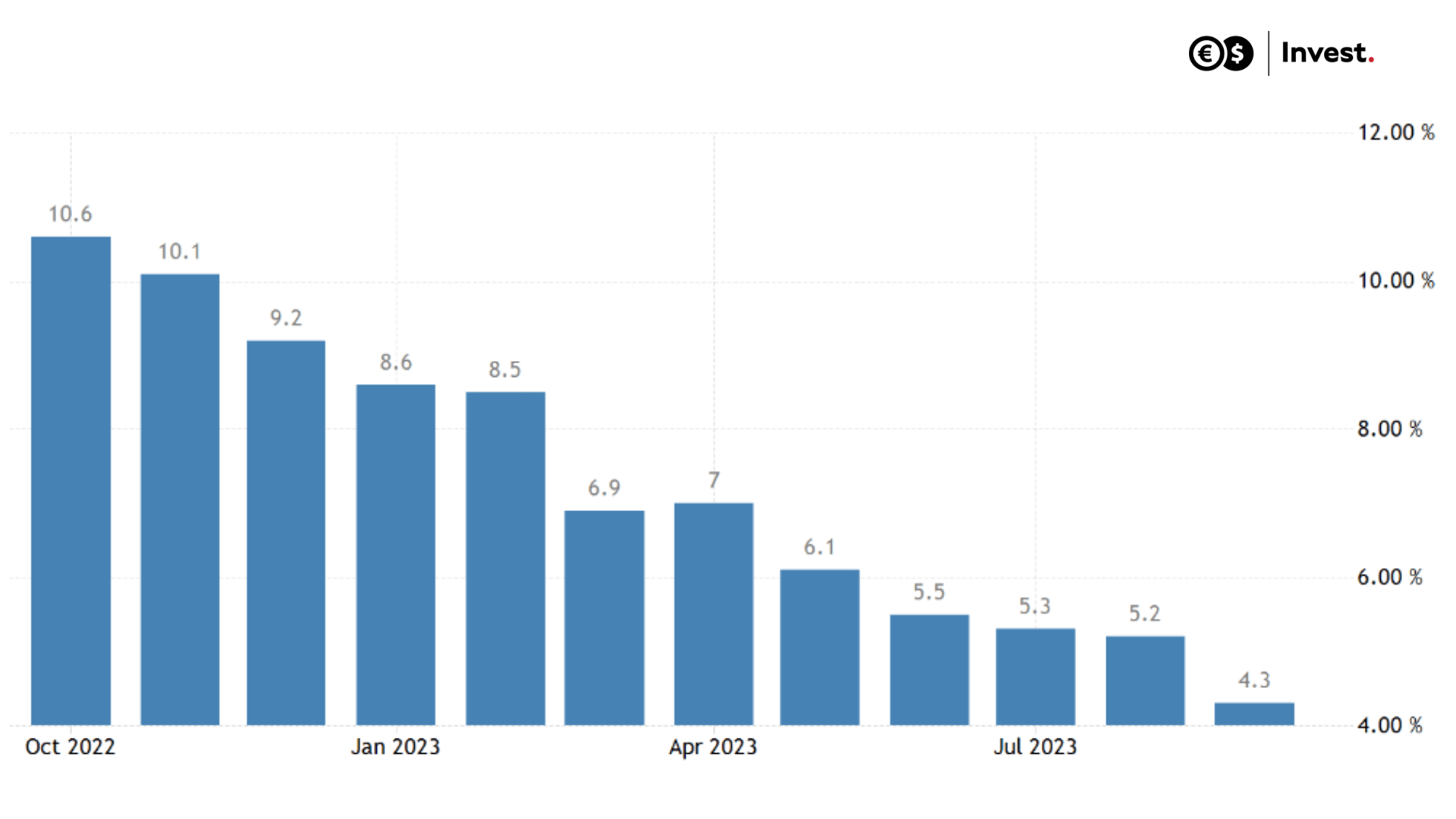
Source: Tradingeconomics.com
On the one hand, if the reading is higher than expected, it means higher inflation, favouring a fall in the euro, but on the other hand, it is an incentive for the ECB to raise interest rates and reduce the money supply. From that point of view, it could suggest a rise in the euro's value. However, if the reading is lower than expected, it would mean lower inflation, but it could give the ECB an argument to cut interest rates and increase the money supply.
Impact: EUR
Wednesday, 01.11. 18:00 GMT, Federal Reserve Interest Rate Decision
Federal Open Market Committee (FOMC) members vote on whether to raise, decrease, or leave interest rates unchanged. These decisions affect the currency's value, and interest rate policy is among the key instruments to regulate inflation. Investors closely follow central banks' decisions and changes in the level of interest rates, as this information can be crucial to their trading strategies. The currency's value tends to rise when interest rates are high, as they attract investors seeking higher returns on their deposits. Conversely, when interest rates are low, the currency's value tends to fall as investors look for other places to invest their money.
During an address at the Economic Club of New York, Federal Reserve Chair Jerome Powell emphasised the Fed's cautious approach. He stated that policymakers would base their decisions on the level of additional policy adjustments and the duration of policy restrictiveness on a comprehensive assessment of incoming data, the evolving economic outlook, and the overall risk balance.
Powell further highlighted that the current tight policy had a dampening effect on economic activity and inflation. Nevertheless, he pointed out that if there were additional indications of consistent growth above the long-term trend or cessation in the labour market's easing tightness, it might endanger the progress towards achieving the inflation target and necessitate further monetary policy tightening.
The Fed Chair also underscored the persistence of elevated inflation levels, noting that achieving a sustainable return to the 2% inflation goal would likely require a period of economic growth below the long-term trend and some additional softening in labour market conditions.
In its September 2023 meeting, the Federal Reserve retained the target range for the federal funds rate at an elevated level, which was the highest it had been in 22 years, specifically at 5.25% to 5.5%. This decision reflects the Fed's ongoing commitment to addressing economic conditions and maintaining a balance between inflation control and economic growth. The CME FedWatch tool forecasts that the federal funds rate will stay unchanged in the upcoming FOMC meeting.
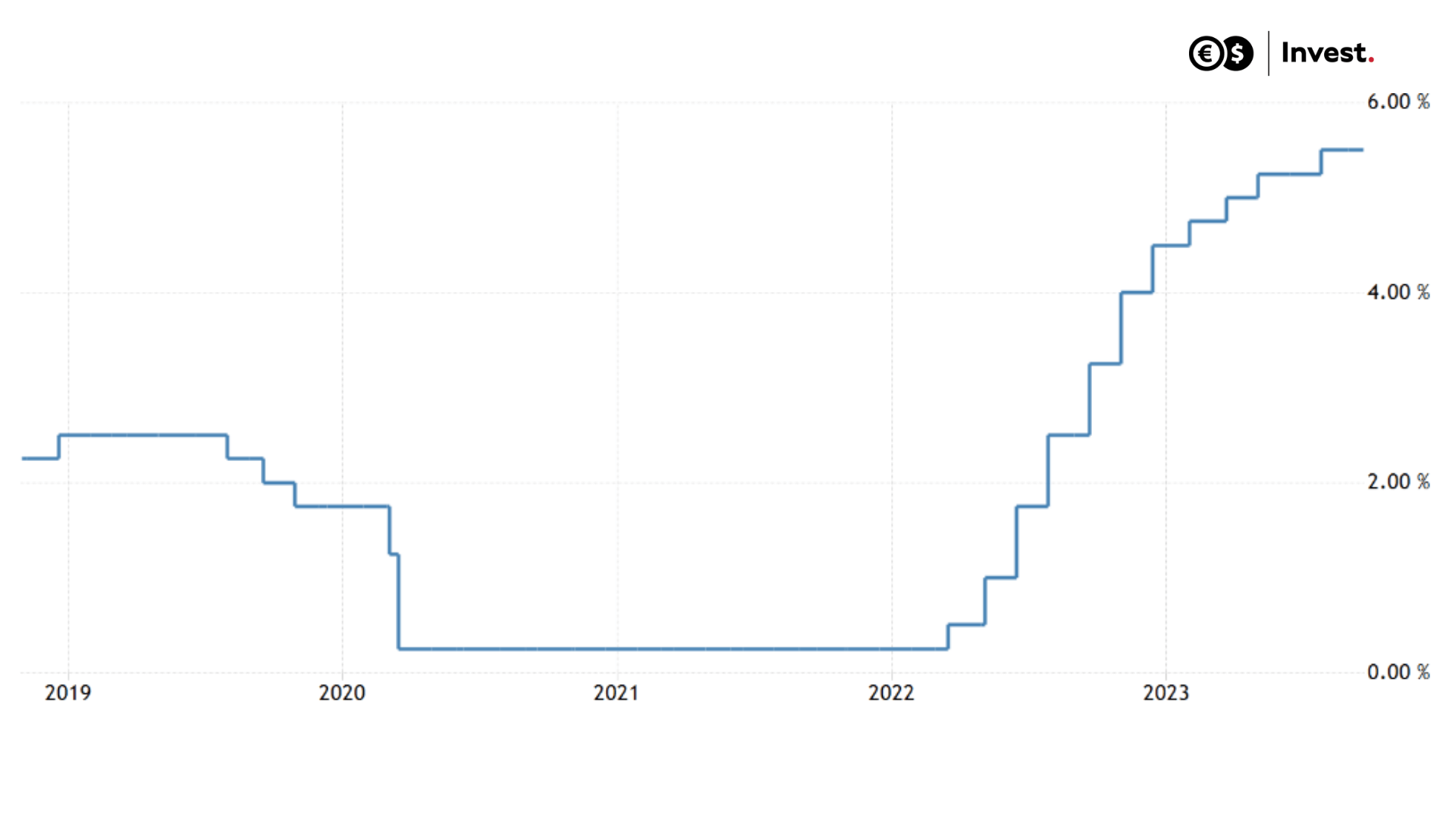
Source: Tradingeconomics.com
A higher-than-expected rate may be positive for the USD and negative for the stock market, while a lower-than-expected rate may be negative for the USD and positive for the stock market.
Impact: USD, S&P500, Nasdaq 100, Dow Jones and other indices
Thursday, 02.11. 12:00 GMT, Bank of England Interest Rate Decision
At its last meeting, the Bank of England decided to keep its key interest rate at 5.25%, which came as a surprise given that it was expected to rise by 25 basis points to 5.50%. Nevertheless, the decision kept borrowing costs at their highest level since 2008. Policymakers adopted a cautious, wait-and-see approach after reviewing the latest inflation and labour market data. These data suggested that the cumulative effects of previous policy tightening might be starting to materialise.
This marked a significant development as it was the first instance of a pause in policy tightening in almost two years. Prior to this, the central bank had executed an unprecedented series of interest rate hikes, totalling 515 basis points.
The BoE conveyed its expectation that CPI inflation would experience a notable reduction soon. This was attributed to the anticipated decrease in energy-related inflation, despite renewed upward pressure from oil prices, as well as the further decline in food and core goods price inflation. No further interest rate hikes are expected this year, according to consensus and Trading Economics analysts.
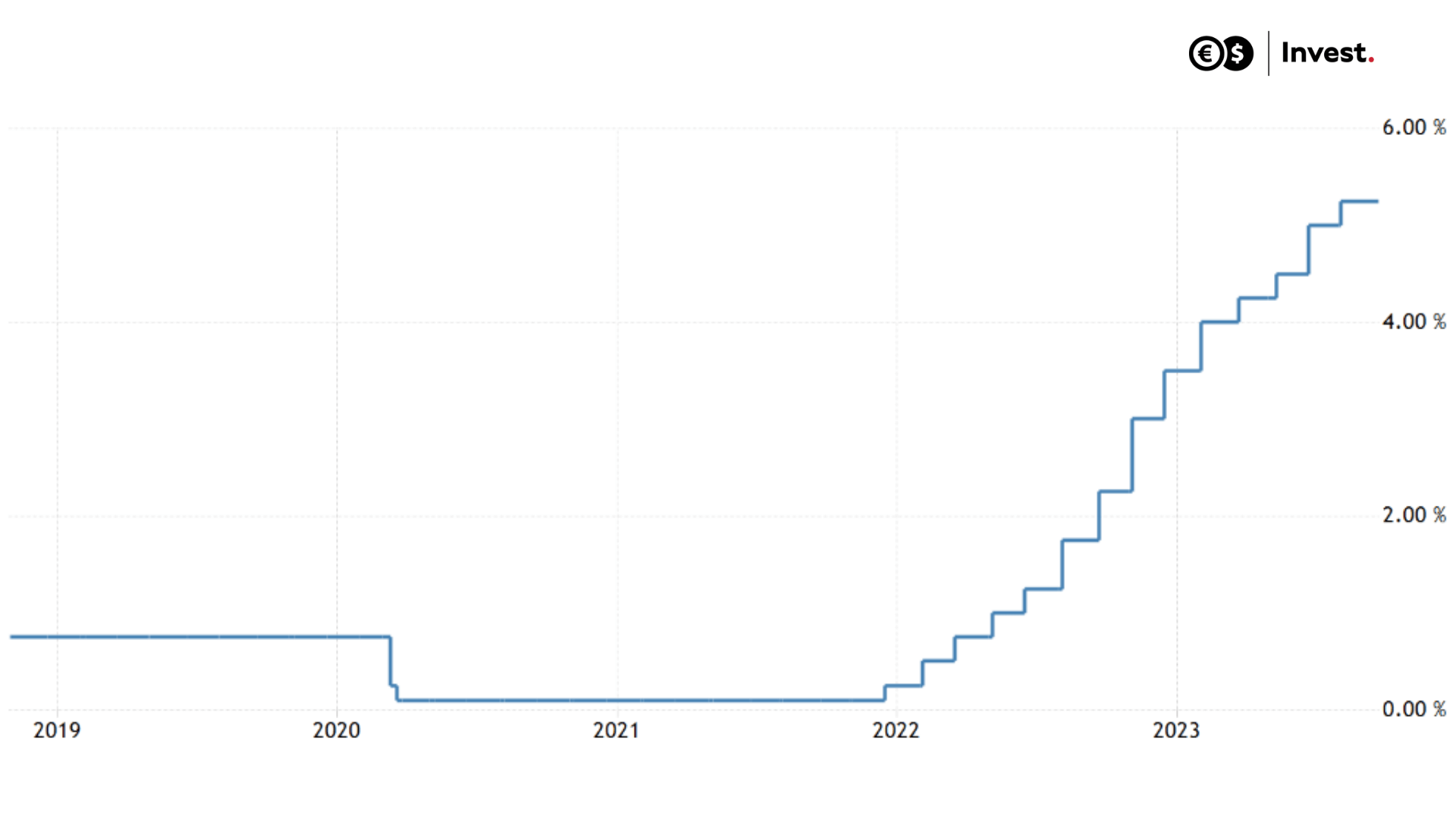
Source: Tradingeconomics.com
A higher-than-expected rate may be positive for the GBP and negative for the stock market, while a lower-than-expected rate may be negative for the GBP and positive for the stock market.
Impact: GBP, FTSE 100 and other indices
Friday 03.11. 12:30 GMT, US Unemployment Rate (October)
The unemployment rate is the percentage of people without a job actively seeking employment in the previous month relative to the total number of people of working age or in the labour market. A high unemployment rate means that a large number of people are out of work despite actively seeking employment. A low unemployment rate indicates a stable labour market and greater availability of jobs.
Unemployment rates are important for economic analysis and can affect social and economic aspects. A high unemployment rate is associated with lower incomes and increased poverty, while a low unemployment rate promotes increased wages and social welfare. Governments and policymakers monitor the unemployment rate to assess the effectiveness of employment policies and take action to create jobs and support the unemployed. However, it should be remembered that the unemployment rate is one of many tools for assessing the labour market. Analysing other indicators, such as the labour force participation rate or wages, is also essential.
The US unemployment rate held steady at 3.8% in September, unchanged from the previous month and slightly above market expectations of 3.7%. This outcome underscores the enduring tightness of the labour market in comparison to historical standards. It provides further latitude for the Fed to maintain borrowing costs at levels considered restrictive for an extended period. However, the slight uptick in the unemployment rate in the last two months may indicate that the Fed's tightening activities are working.
The number of individuals classified as unemployed remained largely unchanged at approximately 6.36 million people. The U-6 unemployment rate, a broader measure that includes those who have given up looking for work and those working part-time because they cannot find full-time work, fell slightly to 7%. This was after reaching a 15-month high of 7.1% in August. At the same time, the labour force participation rate remained unchanged at 62.8%. This is the highest rate since February 2020.
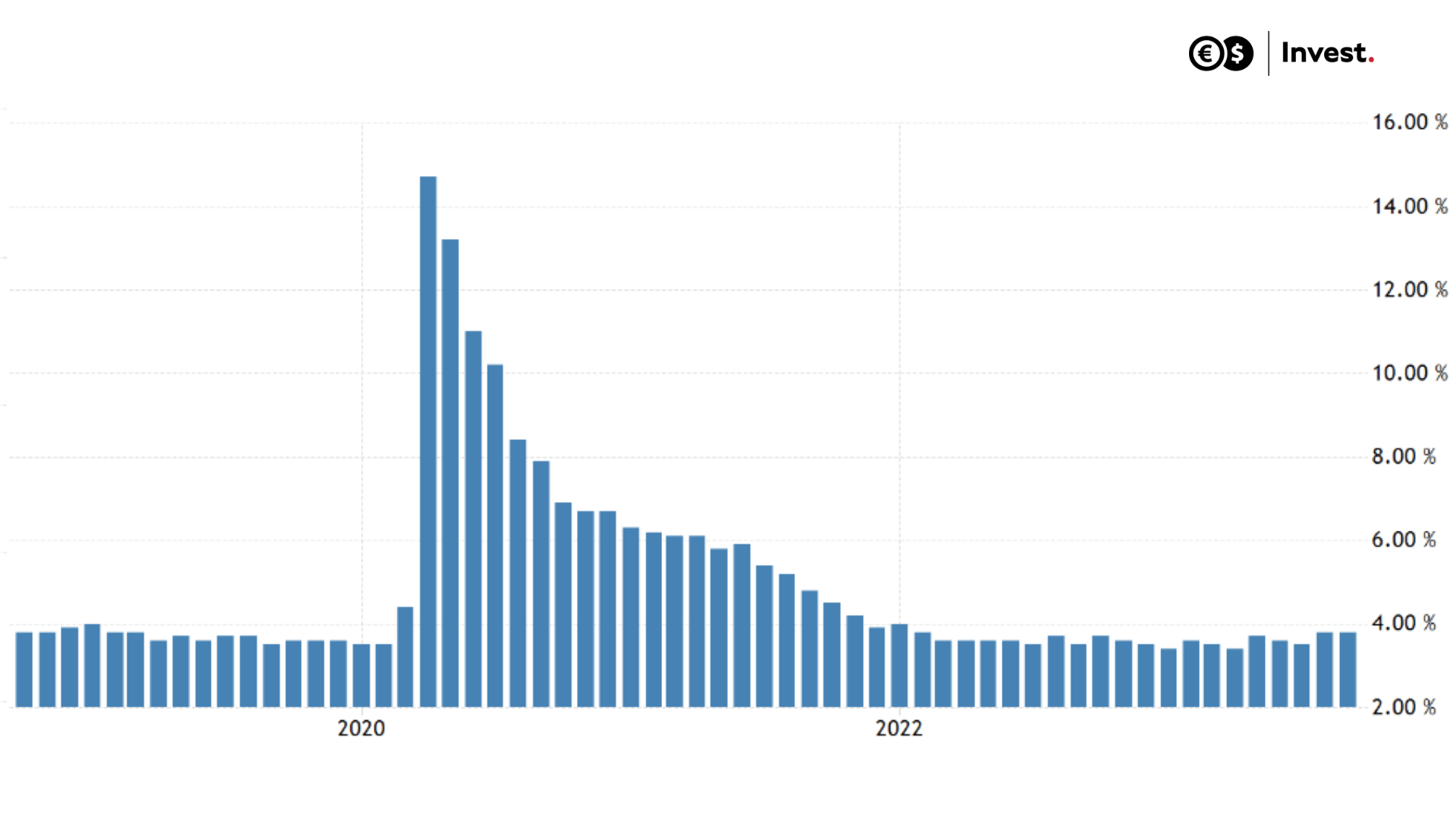
Source: Tradingeconomics.com
A higher-than-expected reading may have a bearish effect on the USD, while a lower-than-expected reading could be bullish for the USD.
Impact: USD
Stocks to watch
McDonald’s (MCD) announcing its earnings results for the quarter ending on 09/2023. Forecast EPS: 3. Positive earnings surprise in 9 out of the last 10 reports. Time: Monday, October 30, before the market opens.
Arista Networks (ANET) announcing its earnings results for the quarter ending on 09/2023. Forecast EPS: 1.58. Positive earnings surprise in 10 out of the last 10 reports. Time: Monday, October 30, after the market closes.
Amgen (AMGN) announcing its earnings results for the quarter ending on 09/2023. Forecast EPS: 4.67. Positive earnings surprise in 8 out of the last 10 reports. Time: Tuesday, October 31, before the market opens.
Airbnb (ABNB) announcing its earnings results for the quarter ending on 09/2023. Forecast EPS: 2.12. Positive earnings surprise in 8 out of the last 10 reports. Time: Wednesday, November 1, after the market closes.
PayPal Holdings Inc (PYPL) announcing its earnings results for the quarter ending on 09/2023. Forecast EPS: 1.23. Positive earnings surprise in 9 out of the last 10 reports. Time: Wednesday, November 1, after the market closes.
Apple (AAPL) announcing its earnings results for the quarter ending on 09/2023. Forecast EPS: 1.39. Positive earnings surprise in 8 out of the last 10 reports. Time: Thursday, November 2, after the market closes.
Starbucks (SBUX) announcing its earnings results for the quarter ending on 09/2023. Forecast EPS: 0.9732. Positive earnings surprise in 7 out of the last 10 reports. Time: Thursday, November 2, before the market opens.
Santa Zvaigzne-Sproge, CFA, Head of Investment Advice Department at Conotoxia Ltd. (Conotoxia investment service)
Materials, analysis, and opinions contained, referenced, or provided herein are intended solely for informational and educational purposes. The personal opinion of the author does not represent and should not be constructed as a statement, or investment advice made by Conotoxia Ltd. All indiscriminate reliance on illustrative or informational materials may lead to losses. Past performance is not a reliable indicator of future results.
CFDs are complex instruments and come with a high risk of losing money rapidly due to leverage. 72.95% of retail investor accounts lose money when trading CFDs with this provider. You should consider whether you understand how CFDs work and whether you can afford to take the high risk of losing your money.


